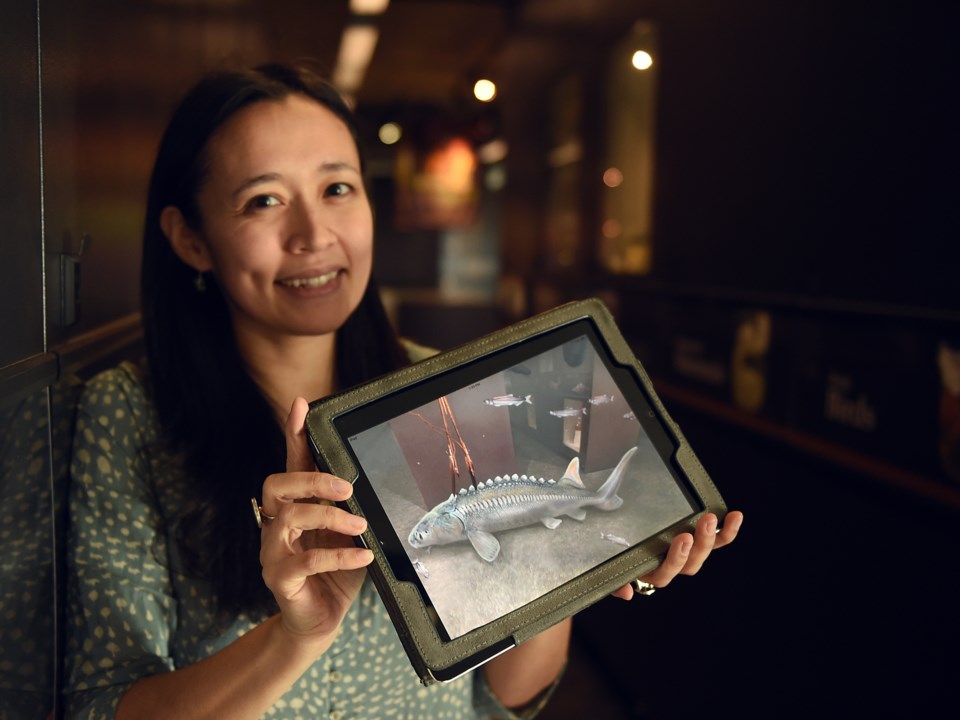An exhibit at the Beaty Biodiversity Museum at the University of B.C. has received the Governor General’s History Award for Excellence in Museums. The exhibit, Sturgeon Harpoon Knowledge Web, is a collaboration between the museum and the Musqueam First Nation, and explores the interconnectedness between nature, culture, language and technology.
The museum is perhaps best known for its 82 foot blue whale skeleton — the largest in Canada — which hangs at the entrance to the underground bunker containing more than two million natural history specimens.
The Sturgeon Harpoon exhibit relies less on physical specimens, and exists mostly in the digital realm, with online interactive elements and virtual reality checkpoints within the museum.
The only two physical specimens in the exhibit are unique, in that the public can actually touch them.
“These are our first unsupervised, touchable exhibits at the museum,” says exhibits manager Yukiko Stranger-Galey, gesturing to a display of reeds. “There’s so many different ways of learning and they say that touch and smell can trigger memories.”
She runs her fingers across the reed’s rough surface, which is covered in microscopic silica crystals. “This scouring rush was used like sandpaper in the process of making the sturgeon harpoon.”
The harpoon is a traditional Musqueam fishing tool which has not been built or used for generations, due to a self-imposed moratorium on harvesting sturgeon. The fish, which was declared a species at risk in 1994, is the largest freshwater species in North America. It can grow up to six metres long, weigh up to 600 kilograms and live to more than 100 years.
A 35-foot-long sturgeon harpoon has been created by Morgan Guerin, and will eventually be on display in the exhibition, once it clears the museum’s strict quarantine process. Guerin, who is a fisheries officer and elected councillor for the Musqueam, built the tool by drawing upon the oral history of his band.
For the purposes of the exhibition, the harpoon functions as a window into an interconnected web of knowledge. “We took the harpoon as our starting point, and from there, picked a few species to illustrate the connections between culture, technology and language,” says Stranger-Galey.
The ongoing exhibition will act as an extension and evolution of oral history for both the Musqueam and the wider public.
“This is a living exhibition, which we’ll continue to add to,” says Stranger-Galey. “We hope that over time, other Musqueam knowledge-keepers will have information they wish to share, to help build this digital repository.”
Visitors to the museum can also use their digital devices to access an interactive, virtual element of the exhibit. At two locations in the museum, users can peer through the screens of their phones or tablets to glimpse a 360 degree view of a natural environment.
The first location transports the viewer to a heavily wooded forest, the second to the bottom of a river, filled with salmon, sea lions and, you guessed it, sturgeon. Hovering just above one of the sturgeon is the tip of a harpoon, and if visitors tilt their phone or tablet screens up, they can see the surface of the river, the bottom of a canoe and the fisherman on the other end of the harpoon.
“It’s amazing to think that there could be a sturgeon in the river right now that was alive a hundred years ago,” says Stranger-Galey. “Imagine the memories they might hold.”
The Beaty Biodiversity Museum is located at 2212 Main Mall, University of British Columbia. More info at beatymuseum.ubc.ca.



